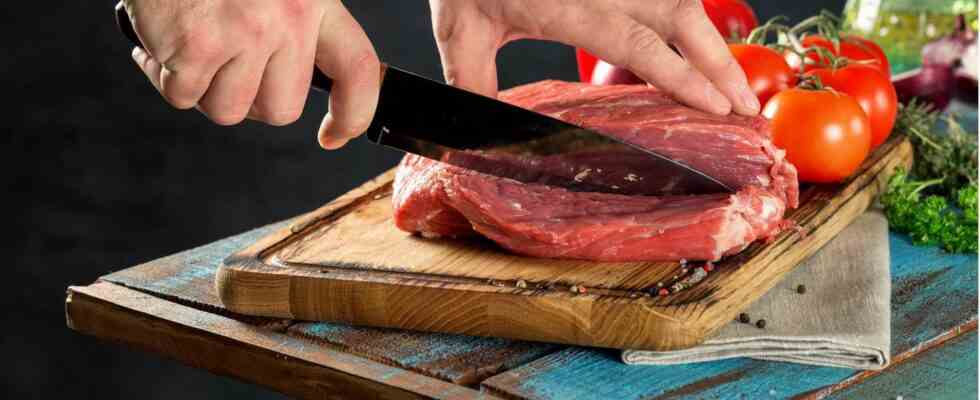The Golden cut
Tender or tough: That’s why it’s important how you cut your (raw) meat
Meat is much easier to cut with the right knife
© KucherAV / Getty Images
In addition to the cooking time, the cutting technique plays an important role in the preparation so that a piece of meat remains tender and juicy after searing: The direction of the grain determines how you have to cut the meat.
If meat chews like a dry shoe sole after cooking, the cooking time is not necessarily to blame for the bad taste. In fact, how you cut your meat has a huge impact on the quality of the meal. Especially when the meat is firmer from the ground up. Due to the different amounts of meat and muscle fibers and connective tissue, the wrong cutting technique is less noticeable with chicken breast than with a steak. However, if you value tender meat, you should know the most important rules when cutting. What these are and why the types of knives are also decisive for the cutting technique is explained as follows.
Cutting meat: This is the right technique
There are only two ways to cut meat: either parallel or across the grain – but only one variant is correct. This is simply due to the length of the fibers, which are very difficult to chew and make the meat as tough as a shoe sole. They are largely preserved if the meat is cut through parallel to the fibers (i.e. the white stripes). If, on the other hand, you cut the meat across the fibers, they do not have to be divided when chewing. This makes the meat much easier to chew. In plain language this means: Always cut across the grain. Because long fibers make the meat tough and short fibers make it tender. This applies equally to raw and cooked meat.
That’s why a carving knife is the best choice
If you chop meat with a knife that is too small, “clean” cuts will not be possible. On the contrary: If the cut surface frays, this has a negative effect on the cooking process. In other words, the meat is tough. For this reason there are special carving knife, which are characterized by a long and narrow blade. With them, the meat is cut through smoothly and is beautifully tender and juicy after preparation. However, you should always make sure that your knife is sharp – because a blunt blade does not create a smooth cut. Here you can have a classic knife sharpener or knife block Use with a ceramic whetstone to sharpen the knife.
These knives are suitable for cutting meat:
- Total length: 33 cm
- Blade length: 20 cm
- Material: stainless steel
- Total length: 36 cm
- Blade length: 24 cm
- Material: quality steel
- Total length: 32.5 cm
- Blade length: 20 cm
- Material: Alloy Steel
- Total length: 32.3 cm
- Blade Length: 8″
- Material: damascus steel
- Blade length: 20 cm
- Material: damascus steel
Cutting meat: The best tips and tricks
In addition to the right technique and a sharp knife, there are other tricks that you can take to heart when cutting meat:
- If the meat fibers run diagonally, such as in a piece of tenderloin, you must also cut the meat diagonally to the grain. Otherwise, the 90-degree rule always applies.
- Possible tendons are removed along the direction in which they run, i.e. you first cut the meat in half and separate it from the meat – before you chop it across the grain.
- If you want to prepare a goulash, the meat must also first be cut across the grain in slices before you then cut it into small pieces.
- If the fibers do not all run in the same direction, such as in the case of pork belly, cut across the main direction anyway – use most of the fibers as a guide.
- If you are unsure how to cut the meat, you can snip off a small piece. You can see the direction of the grain better when you cut it.
- Another way to determine the direction of the grain is to cut off a piece of meat and sear it briefly. If it’s tender, you’re right. If it’s tough, you have to try again.
You might also be interested in:
This article contains so-called affiliate links. There is more information here.



